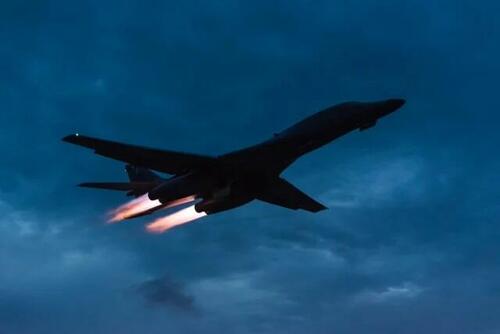US Strikes At Least 85 Targets In Iraq & Syria, Including From B1 Bombers
At 4:00 p.m. (EST) Feb. 02, U.S. Central Command (CENTCOM) forces conducted airstrikes in Iraq and Syria against Iran’s Islamic Revolutionary Guards Corps (IRGC) Quds Force and affiliated militia groups. U.S. military forces struck more than 85 targets, with numerous aircraft to include long-range bombers flown from United States.
The airstrikes employed more than 125 precision munitions. The facilities that were struck included command and control operations centers, intelligence centers, rockets, and missiles, and unmanned aerial vehicle storages, and logistics and munition supply chain facilities of militia groups and their IRGC sponsors who facilitated attacks against U.S. and Coalition forces.
The Biden administration is promising this is not the end of it, and the campaign could last for days or more.
First images circulating on Telegram of U.S. airstrikes on #IRGCterrorists at Al-Qa'im, #Iraq. pic.twitter.com/GFutNoyGVM
— Jason Brodsky (@JasonMBrodsky) February 2, 2024
* * *
Update(1640ET): The Biden administration has begun its much anticipated retaliatory strikes:
FIRST US MILITARY RETALIATORY STRIKES UNDERWAY IN SYRIA: ABC
Regional analyst Kevork Almassian comments as this initial wave of attacks begins: "The US air force is bombing Eastern Syria near al-Mayadeen. Syria is a sovereign country which has not attacked the United States. A clear violation of international law." US B1 bombers have been involved, according to officials. Initial unconfirmed footage from the region:
Breaking: this was sent to me from Al-Qaem, Iraq moments ago, you can hear the huge explosions in the distance from the Syrian-Iraqi border area. pic.twitter.com/A4fccWLJ9u
— Steven Nabil (@thestevennabil) February 2, 2024
The Department of Defense has since suggested the initial eastern Syria strikes which were first reported might be the work of a partner air force, possibly Israel(?). There are a number of reports suggesting Israel is participating as a partner force. Additionally:
- Initial report of a US attack against targets in the Deir ez-Zor area on the Syria-Iraq border.
- US Official confirms strikes occurring in Iraq and Syria. “8 targets is just first of many courses” so far
- Reuters, citing American officials: “The strikes targeted facilities in Iraq and Syria linked to the Iranian Revolutionary Guard and groups that it supports.”
- Start time was about 4 p.m. Eastern Time.
The administration appears to have waited until market close on Friday to start bombing.
BREAKING: US AIRSTRIKES HAVE ALLEGEDLY HIT 12 TARGETS IN MAYADIN AND ABU KAMAL WITH 10 DEAD AND 18 WOUNDED pic.twitter.com/GkUOyjsOnJ
— Sulaiman Ahmed (@ShaykhSulaiman) February 2, 2024
Significant casualties are being reported, and will likely trickle out through the evening.
Confused messaging coming from Biden administration and mainstream reports:
Total chaos in U.S. messaging tonight — with officials confirming & denying US strikes in #Syria & #Iraq tonight.
You’d think after taking 5 days to message every possible detail to #Iran, that confirming action would be simple.
Seems not.
— Charles Lister (@Charles_Lister) February 2, 2024
* * *
French container shipping giant CMA CGM has announced suspension of all its Red Sea transit due to security risks, Bloomberg has reported Friday, adding to a growing list of major firms now deeming the area too unsafe.
The Bloomberg note additionally confirms that "CMA CGM will keep operating in the northern Red Sea but will not send its fleets through the southern part that is unavoidable for any vessel seeking to use Egypt’s Suez Canal to go between Europe and Asia." With every addition of a shipping major, there's yet further confirmation that the US-led 'Operation Prosperity Guardian' is failing.

"Hundreds of container ships and large numbers of oil tankers and commodity carriers have elected to avoid the area altogether," Bloomberg underscores.
Until this week, CMA CGM had continued sending some vessels through the vital transit passage despite the almost daily Houthi missile and drone attacks, but which have been supported by French navy escort. But at this point it appears even the large Western warship presence isn't enough.
This week, the US Navy saw its closest call yet when a Houthi-launched cruise missile came within a mere mile of the destroyer USS Gravely.
Details have only just emerged late in the week based on the accounts of several US defense officials. Presumably other longer range anti-air defenses failed as the missile was inbound close the ship. CNN describes:
In the past, these missiles have been intercepted by US destroyers in the area at a range of eight miles or more, the officials said. But the USS Gravely had to use its Close-In Weapon System (CIWS) for the first time since the US began intercepting the Houthi missiles late last year, which ultimately succeeded in downing the missile, officials said.
The CIWS, an automated machine gun designed for close-range intercepts, is one of the final defensive lines the ship has to shoot down an incoming missile when other layers of defense have failed to intercept it.
So this "last line of defense" which utilizes a 20 mm radar-guided canon had to be activated. The mounted weapon is a General Dynamics and Raytheon-produced ship defense system which engages closely inbound targets...
Wow, the USS Gravely had to use its Phalanx CIWS against a Houthi cruise missile per a U.S. official to CNN.
This is essentially the ships last layer of defense against any incoming attacks.
(The video below shows one in action!) pic.twitter.com/I1SYYydbbZ
— Global: Military-Info (@Global_Mil_Info) January 31, 2024
Fox News' Pentagon correspondent Lucas Tomlinson has said this week marks the "first time in history CIWS ('sea-wiz') has been used in combat from a warship to destroy an incoming cruise missile seconds away from impact.
What has been clear based on other recent incidents is that Houthi drones and missiles are in some instances slipping through the Western navel coalitions 'defense umbrella'.
We detailed a week ago how the US Navy essentially "lost a battle at sea" given that a missile landed in the water very close to a commercial vessel which was being escorted by no less than three US warships. During that time two American merchantmen - the Maersk Detroit and the Maersk Chesapeake - had been attempting to run the Bab al-Mandeb from south to north while being covered by the USS Gravely. But as with this fresh incident of the Gravely's CIWS system having to engage at close range, one missile apparently slipped through in that Jan.17 encounter.
Below is a very different 'close call'...
The MK-15 Phalanx CIWS, a defense system on U.S. Navy ships, can automatically track and target threats.
Here it’s shown targeting a commercial aircraft, likely in semi-automatic mode. pic.twitter.com/d3sUeo2n3C
— VisionaryVoid (@VisionaryVoid) January 30, 2024



